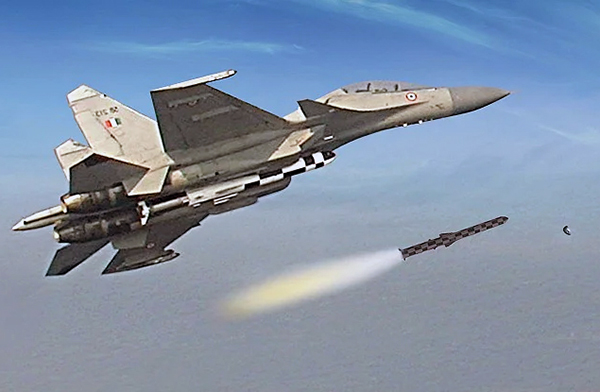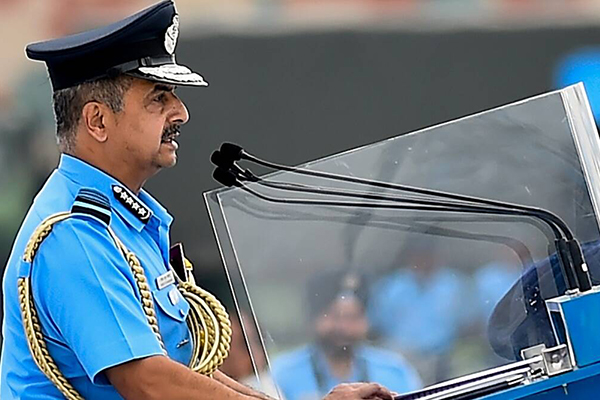Mirages, MiG 29s, Jaguars, MiG-21s to be Phased Out
The Indian Air Force (IAF), which is down to 31 fighter jet squadrons (some 16-18 planes in each squadron), is banking on rapid induction of the indigenous Tejas and a separate programme with a foreign partner to ramp up numbers.
The IAF Chief, Air Chief Marshal VR Chaudhari, while addressing a press conference ahead of Air Force Day, said 83 of the Tejas Mark 1-A are on order and the proposal to make 114 medium-range fighter aircraft (MRFA) in India has been finalised. The foreign manufacturers in the MRFA project have been asked to have a greater “Make in India” commitment.
Another 10 planes of the first lot of 40 Tejas will be delivered this year. “The project to get 12 additional Sukhoi-30 MKI and 21 of the MiG-29 is deferred,” he added.
On further long-term projects, the IAF chief said the force was committed to the indigenous Tejas Mark 2 and is looking at six squadrons and also the Advanced Medium Combat Aircraft (AMCA).
The IAF will phase out the three squadrons of MiG-21 by 2024. The phasing out of the fleet of Jaguar jets — six squadrons — will start from 2025 and continue till 2032. By that time, the Mirage 2000 and MiG-29 fleets — three squadrons each — would be scheduled for phasing out, the IAF chief added.
The chief added, “With the given numbers (31 squadrons), it will be impossible to keep watch and do combat air patrol all across the country.” The target of 42 squadrons would remain even though it may take a decade to meet it, the IAF chief said.
‘Transforming for the Future’
The theme for this year’s anniversary celebrations – ‘IAF: Transforming for the Future’ — was very apt and highlighted the Indian Air Force’s need to redefine, reimagine and recalibrate to transform into a contemporary and future-ready force, the Air Chief said.
“Our fighting potential has to be sustained over the years through the induction of 4.5 Gen fighters, AWACS, AEW&C and flight refuelling aircraft. We have initiated necessary steps to ensure our fighter squadron strength remains at the desired level. Indigenous development of six AEW&C Mk-II has been sanctioned and we are actively pursuing the acquisition of ISTAR, UAVs, Counter UAS technology and strengthening our networks,” he said.
Modern armed forces, he said, have to be sufficiently self-reliant to ensure minimum disruptions. “Towards this, Atmanirbharta and Make-in-India are a step in the right direction. Our indigenous operational network AFNET, the backbone of all air operations IACCS, one of the largest maintenance management protocols e-MMS and the fact that we are completely paperless in our offices through the e-Office application is a testimony to our commitment towards becoming self-reliant,” he said.
The LCA, ALH, Akash surface-to-air missile, Astra BVR, LCH and Brahmos, he said, are a few examples of the indigenous hardware that has already been inducted and operationalised.
He said the IAF has signed a contract for 83 LCA Mk 1A and is fully committed to the development of LCA Mk-II and the AMCA.
“The advent of drones, swarm drones, hypersonic weapons and space based ISR systems have added a new dimension to war fighting. To effectively handle the full spectrum, artificial intelligence is being used for quicker decision-making and analysis of big data. I am happy to report that several projects are well underway to utilise the potential of automation, data analytics and artificial intelligence to transform our operational philosophy,” he said.
Phasing Out of Obsolete Aircraft
The Indian Air Force (IAF) maintains that its sanctioned strength of 42 fighter squadrons will remain sacrosant, even though its current numbers have fallen to 31 squadrons. In actual terms, 31 squadrons doesn’t mean “31 squadrons” because the availability ratio of some of the aircraft types was less than 50 percent.
With the growing presence of both Pakistani and Chinese Air Forces, for the IAF, quantity matters when it comes to the ability to operate in a large geographical area and persistence which refers to the ability to conduct 24×7 air patrols. However, even if the entire planned procurement happened without any glitch or time delays, the IAF may just about reach 35 squadrons, against a sanctioned strength of 42, by 2035-36.


Achieving the sanctioned strength of 42 squadrons by 2036 is dependent upon the induction of the Tejas Mark 2, the indigenous 5th generation Advanced Medium Combat Aircraft (AMCA) and 114 fighter aircraft for which a Request For Proposal (RFP) is still awaited.
Over the next 15 years, multiple squadrons would be phased out, starting with the three remaining MiG 21 Bison squadrons, which would be out of service by 2025. Following this, six squadrons of aging Jaguars would start being phased out as well, a process that will end by 2031-32. That is when the upgraded fleet of the Mirage 2000s and the MiG 29s will start getting phased out.
Last of the Remaining MiG-21s to Retire
The IAF is set to retire one of its four remaining squadrons of the ageing MiG-21 fighter jets on September 30. The other three MiG-21 squadrons will be phased out by 2025.
Several MiG-21s have crashed in recent years, with the accidents turning the spotlight on India’s longest-serving fighter plane, its safety record and IAF’s plans to replace the ageing jets with newer models in the coming years. Over 400 MiG-21s have been involved in accidents over the past six decades, killing around 200 pilots.
More MiG-21s have crashed than any other fighter jets because they formed the bulk of the combat aircraft in the IAF’s inventory for a long time. The air force had to keep its MiG-21 fleet flying longer than it would have liked because of delays in the induction of new aircraft, as previously reported.
The air force got its first single-engine MiG-21 in 1963, and it went on to induct 874 variants of the Soviet-origin supersonic fighters to bolster its combat potential.
IAF is inducting different variants of the indigenous Tejas light combat aircraft to replace the MiG-21s.
Replacements Planned
The IAF has already ordered 83 LCA Tejas Mk 1A and plans to place an order for the Tejas Mk 2 as well besides the indigenous 5th Generation fighter aircraft, both of which are still in the design phase.
The IAF is keen on the 114 Medium Role Fighter Aircraft (MRFA) for which it is in the process of firming up the technical requirements, following which a “Request for Proposal (RFP)” would be sent out.
The tender has been pending for long. While initially it was felt that the government may go in for a strategic decision and enter into a government to government contract with France for more Rafale, it appears that the controversy surrounding the original deal has made the government wary. Hence, a decision has been taken to go in for a MRFA contest. The IAF is in the process of taking commitments from the vendors regarding the indigenization element.
IAF to Get New Weapon Systems Branch
Moving to synergise operational requirements of the Indian Air Force, the government has approved the creation of a new Weapon Systems branch which will be responsible for all IAF weapon system operators, and bring them under one roof. The announcement was made by the IAF chief on Air Force Day 8 October.
The Branch will cover four specialised streams of surface-to-surface missiles, surface-to-air missiles, remotely piloted aircraft and weapon system operators in twin and multi-crew aircraft. Creation of this branch will result in savings of over Rs 3,400 crore due to reduced expenditure on flying training.
The establishment of a separate branch for missile system operators, unmanned aerial vehicles and weapon system officers of two-seater aircraft is an effort to synergise operational requirements which differ from active flying.
A specialised branch will facilitate induction of more complex weapon systems. The weapon systems operator in a twin-seater aircraft does not have to be a full-fledged pilot as his core competence is handling the weapons on board. It would do away with piecemeal deployment of officers from non-specialised branches and institutionalise the non-flying operational cadre. Pilots would be spared from doing the task, thereby making them available for flying duties. This separate branch is also expected to include officers who specialise as intelligence analysts and operate intelligence-gathering tasks in unmanned aerial vehicles as well as space-based assets. Here again, the need for building core competence in a separate branch has long been felt by the IAF brass, given the increasing role of UAVs and space assets in information gathering and advance warning.













